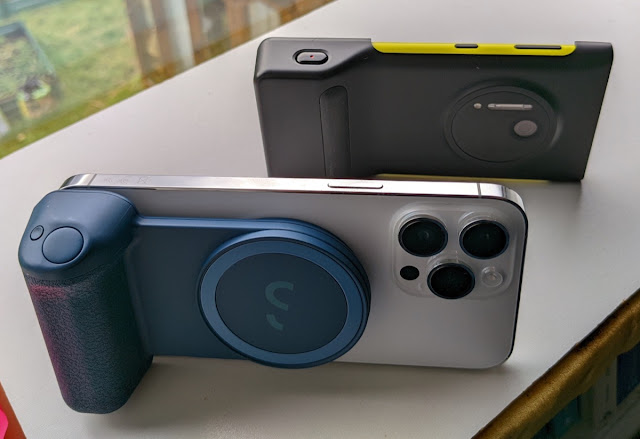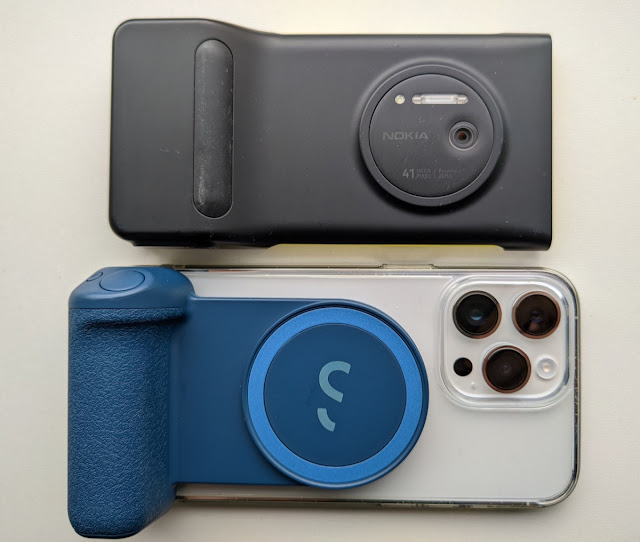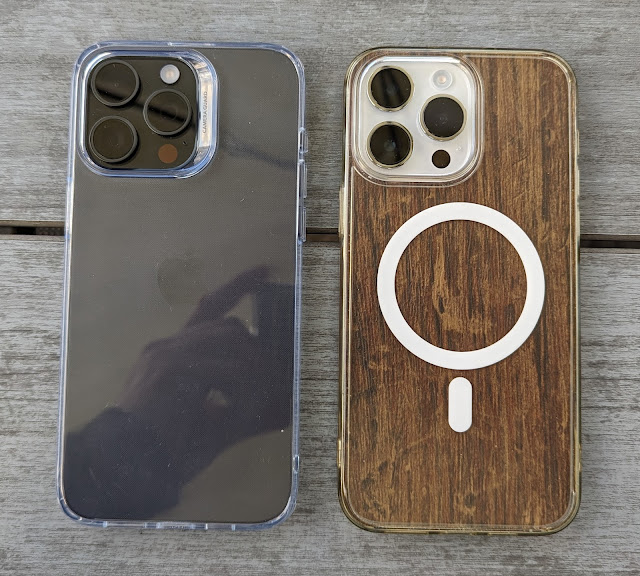Review: ShiftCam SnapGrip
When is a phone camera really a DSLR? When it has a SnapGrip on its back? Not quite, but it kind of feels like it.
So. I bought and am reviewing the ShiftCam SnapGrip, £70 in the UK. Partly spurred by fond memories of the Lumia 1020 PD-95G Camera Grip, which it strongly resembles, in functionality and ambition:
You'll possibly remember the Lumia 1020, from 2013. The camera phone champion of its day, thanks to a 41MP back-illuminated 1/1.5" sensor, OIS, Xenon flash, and computational oversampling. That all sounds rather special today and indeed the 1020 still works well today, see my detailed imaging comparisons over on the archived All About sites:
- The famed Lumia 1020 takes on the DSLR
- Next up... the Lumia 1020 trounces the iPhone 12 Pro Max?!
- A 2021 'PureView' battle: 808/1020/Pixel/iPhone
...among other pieces. Do go and have a read.
The upshot? In ProRAW (unsharpened, un-edge-enhanced, but much larger file size) mode, the modern iPhones comfortably defeat the decade old classic, in purity and detail, factoring in zoom on top, But in default JPG mode, the fight is a lot closer and the 1020 often wins out, spoilt only by the infamous 'yellow cast' in some light conditions.
Introducing SnapGrip and the concept
So yes, the 'grips'. Let's start with the new one, the ShiftCam SnapGrip. The ideas here are:
- Quick/application, the MagSafe circle of magnets make sure it’s aligned and secured instantly on any iPhone 12 or later (or Android phone with the supplied MagSafe adapter, see below)
- Gives a DSLR grip in the hand, with one-handed shooting if needed and the phone held 100% secure via MagSafe
- The extra bulk gives your shots more stability, compared to, say, pressing the vertical shutter button on a Sony phone (or Lumia!), jolting the shot ever so slightly with that movement. Here the shutter is soft and obliquely angled as on a real DSLR
- Simply having a proper, large shutter button (rather than having to use your thumb on the phone screen) gives the feel of a real camera and encourages creativity, you'll want to take more photos(!)
- It can also be used, not snapped to the phone but held separately, as a remote Bluetooth shutter, for err… tripod selfies!
- The Qi charging of the phone while taking photos enables longer snapping sessions etc. The 3200mAh power bank inside comes with Type C recharge. So does the iPhone become a Type C charge device while the grip is snapped on? Kind of...!
- The SnapGrip doubles as a power bank Qi stand, for portrait mode at least - shown in a photo below). Handy for video calls, too?
- The grip swivels, being only held on by the magnets, so it can shoot in portrait or landscape, but obviously looks a bit silly in the former. Still, maybe for TikTok or YouTube Shorts?
- It comes, as mentioned, with a MagSafe sticker (ring of magnets) for attaching to a non-MagSafe phone (e.g. a Google Pixel or Moto or Samsung), though it’s up to you to get the sticker positioning right over your phone’s internal Qi coil for best charging efficiency (I'll cover this non-iPhone use in more detail in a separate article)
That's the theory anyway. I was preparing for a half hearted, poorly made gadget that kept falling off, but the reality is very different. This is a polished accessory that does exactly what it claims, even if ultimately there are a few (mainly software limited) disappointments.
Lumia Grip versus SnapGrip
Much of all this also applied to the original Lumia 1020 PD-95G Camera Grip, though its internal 'power bank' is only 1020mAh (get it? Same as the phone model name, I only realised this recently!!), enough to add 40% battery charge to the Lumia's operation. While the SnapGrip's 3200mAh cell is more like 80% charge, if needed, though it depends which iPhone you snap it on to, since they all have different capacities, of course.
In the Lumia's case, both charging and shutter operation is handled by the microUSB plug built-in, while the SnapGrip uses Qi (wireless) charging and Bluetooth shutter control. But once in the grips, both work in much the same way, giving a 'real camera' feel, complete with ergonomics and texture. The Lumia's PD-95G feels smoother and with a smaller grip panel, plus the shutter button is up top, while the SnapGrip has genuine textured bulk, with a larger shutter button angled at 30 degrees, as on a DSLR.
Saying the Lumia's grip feels like a toy and the SnapGrip like a professional tool is going too far, of course, but you get the idea. Add in the fiddly way the Lumia's grip has to be prised from the phone, with the split second ease of disconnection and reconnection (magnetically) of the SnapGrip, and it's clear which is the better (and more modern, of course) solution.
The Lumia's PD-85G did have a tripod mounting socket, which I'd like to have seen on the SnapGrip but hey, modern iPhones have such good handheld night modes that you never really need a tripod anymore.
The prices aren't that different, interestingly, probably reflecting their niche nature rather than actual manufacturing cost. The PD-85G was retailed at £50 back in 2013, which is more than the SnapGrip's £70 in 2023 money, but they're close.
ShiftCam SnapGrip in detail
On to the ShiftCam SnapGrip in detail then, working out of the box with any iPhone with MagSafe, I believe, though I haven't tried it on a 'mini' (now axed by Apple anyway). Here's what you need to know:
• Bluetooth Pairing with (here) an iPhone 14 Pro Max is very fast. The usual tap in the Bluetooth settings and you're done for good. Auto-reconnection, in a new SnapGrip session, for example, is a second or so after you press the shutter button the first time. After that you're good to go. The Bluetooth connection lasts until the phone is out of range before eventual (60 seconds blinking) auto-disconnect, but it seems very good at hanging onto the connection (tested at 10m). And because it’s also a portable Qi power bank, there’s no shortage of power for keeping Bluetooth going etc.
• Shutter delay was a worry, but it seems as fast as pressing the on-screen shutter to me. Which it should be, since the shutter works by simply emulating a volume key ‘up’ press on the phone. So very low tech but it works well. Not much subtlety, as on the Lumias and Sonys of this world, though, because...
• ...I was kind of hoping for a half press-to-focus and reticule, but of course the iPhone has LiDAR (well, mine does!) and so focussing is always instant and always accurate, all very ‘auto’. The only manual focussing is by tapping on an object in the viewfinder, as usual. Note that there are more ‘Pro’ camera apps on iOS of course, and maybe I can experiment with these and see if behaviour is any different, again something for a future article.
• The solidity via magnets is very impressive. Even through my iPhone TPU case, though admittedly that’s a MagSafe-compatible case with passthrough magnets. The Ringke Fusion. Though for the purposes of clarity I've photographed the SnapGrip here on the phone 'naked'.
Pass through stand charging
The idea of the SnapGrip having a second, separate function is intriguing and, shown here, is its 'stand mode', using the bulk and angle of the accessory to prop up the attached device on a desk, for example, while Qi charging it happily:
What's especially nice here is that pass through charging is supported, i.e. plus a Type C lead into one side, to recharge the SnapGrip, and if a Qi-compatible phone is snapped on the front then this is charged as well, at the same time.
Could one then argue that the SnapGrip makes a great charging desk stand? Well, possibly. But you'd have to keep lifting it slightly off the desk to grab the phone and 'unsnap' it, plus I think I'd rather have the SnapGrip in my coat, ready for imaging action!
In use and verdict
I should mention that I'm a huge MagSafe fan in general. As it the rest of the tech world, with the Qi consortium building the magnet configuration into Qi 2.0, coming soon, across all phones. I use MagSafe Qi pads in the office and bedroom, always keeping my iPhone charged and always with maximum efficiency, centred on the pad.
So to find another MagSafe accessory that's really, really well thought out absolutely thrills me. I realise that for £70 I'm going to be dealing with plastic rather than metal but that's absolutely fine - the SnapGrip is tough and should last a lifetime.
Keeping the SnapGrip in a coat pocket, ready for snapping on magnetically whenever I'm somewhere scenic and feeling creative is nothing short of a pleasure. Obviously you wouldn't use this for every photo of your food or taking casual people snaps, but it's great to have the SnapGrip as an option for when you want to go further and feel like you're a 'pro'.
As with the Lumia grip, the built in power bank is a very nice touch - after all, if you've got to have a little bulk and mass to enable the DSLR 'effect' then why not use that to store some charge? The upshot is that you may never have to worry about using too much juice in a long photography session, because the Qi power bank is more than capable enough to match the drain from the Camera app. The charging function is started with a press of the smaller secondary button, with two presses to turn it off again. I like that charging's not on all the time (as it was with the Lumia grip), since that way you can never have unwanted standby drain and also you don't end up with an 'empty' grip all the time. I was forever recharging the Lumia's PD-85G! Here you have to choice as to whether to initiate phone charging or not.
Being able to swivel the (here) iPhone on the SnapGrip to shoot in portrait mode doesn't really add anything to the experience - you might as well just hold the phone up as usual. But it's possible, and worth noting that ShiftCam also do a MagSafe tripod mount, so combining the two accessories may help your TikTok or YouTube Shorts ambitions?
In short, I love the SnapGrip. Just as I came to love the Lumia grip in time (I was sceptical there because of the fiddly clips and small battery size, but its sheer uniqueness won me over).
It's absolutely not needed by any iPhone owner. It's a luxury, but a multi-functional luxury that anyone with hobbyist imaging in mind will appreciate.
PS. I've now covered this in video form in YouTube Shorts here, giving an overview.
PPS. As mentioned, the SnapGrip also works with Android phones via a supplied MagSafe circular sticker. I’ve now covered this on this blog and in video form here.
PPPS. Over on my YouTube Shorts channel - go subscribe, And as promised, I've now covered iPhone Camera functions that most people don't know about, introducing 'pro' level adjustments. Which work anyway, but are somehow more impressive when your iPhone is formed temporarily like a DSLR anyway!
PPPPS. (sorry for all the PSs!!) If you like this feature and want to support my work then please do so here via PayPal. Thanks.











Comments
It’s currently lent out but I’ll do more tests when I get it back.